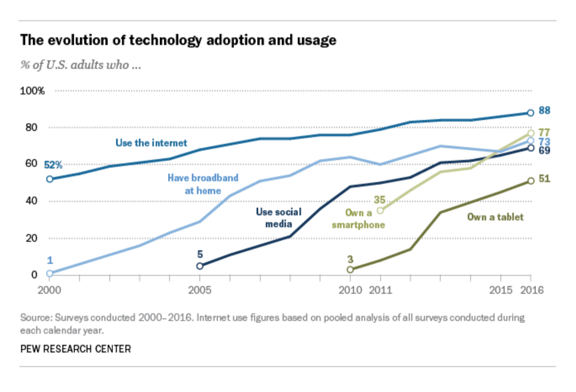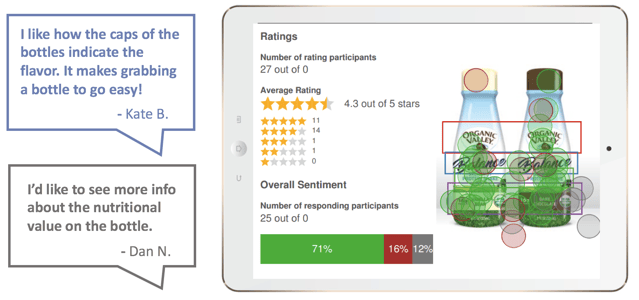Forward-thinking organizations are increasingly turning to faster online qualitative research solutions to make better decisions—and deliver more successful solutions to the market. To get ahead in today’s fast moving business climate, your organization needs to gain the competitive advantages of using these new approaches. But how do you go about selling online qualitative internally if your organization hasn’t yet modernized its approach to research?
Key points:
- Online qualitative research is becoming increasingly popular—and for good reason
- Qualitative enables organizations to make better decisions, faster, and more affordably
- Convincing any organization to change the way it does things can be tricky
- Use these five tactics to increase the chances your company says yes to qualitative
Qualitative research is changing.

Source: http://www.pewresearch.org/fact-tank/2017/01/12/evolution-of-technology/
Thanks to innovation in the digital space, qualitative research is rapidly becoming more relevant to organizations than ever before. In an age where companies are increasingly trying to become more agile, many of them are moving to online qualitative research because it helps them understand what their customers are thinking and it helps them iterate faster—and with confidence.
Over the past few years, qualitative research has moved online to more social media style environments. This shift has enabled organizations to collect deeper, more accurate insights without the incurring the costs and investing the time traditionally associated with qualitative research.
As a result, companies are able to better understand how their customers experience their brands and products, and why they respond to certain products and ad campaigns the way they do. Armed with that information, they can iterate on new products, experiences or marketing programs, increasing the chances that these programs are ultimately successful—which, in turn, drives competitive advantage.
How exactly do you get your organization to buy into qualitative research?
The benefits of online qualitative research speak for themselves.
Unfortunately, you can’t just go to decision makers at your organization and tell them the company needs to use online qualitative research and expect them to be persuaded right off the bat. Organizations, after all, tend to get comfortable doing things the way they do things. It’s often hard to convince people that change, however big or small, is necessary.
So how can you convince folks—many of whom already recognize the value of surveys, focus groups and in-person research because that’s what they’re familiar with—to buy into online qualitative?
Follow these five steps:
1. Socialize the concept and value of online qualitative research
First things first: You can raise the profile of online qualitative research internally by showing its merits.
When you collect data from surveys, the information you report is often shown as charts or graphs that are more general in nature and often represent a broader group of participants.
Qualitative, on the other hand, often provides artifacts—like quotes, videos or stories from highly targeted participants—that help inform specific problems that your team is trying to solve. These findings help the team understand potential solutions in depth—which you can leverage to make better decisions.
Thanks to the evolution of technology, the types of insights you can get from online qualitative far exceed traditional in-person research. For example, you can mix and match between group and individual conversations in a single study. You can also move from structured, survey-like questions to fill-in-the-blank questions and open-ended discussions.
Simply put, online qualitative gives you more flexibility—which is needed to get the best insights.

Further, online qualitative research enables you to capture data anonymously, since folks can share their opinions from the comfort of their own homes and are therefore more likely to be honest. Nobody has to compete against one research participant dominating the conversation either.
The data gleaned from qualitative research can be used to ask follow-up questions, using that data to confirm your understanding and iterate on possible solutions, and repeating the process until you’re happy with the results. This enables you to not have to spend on additional research or simply make your best guess on interpreting results—but instead validate your understanding and lessen your exposure to risk.
Once stakeholders understand the power of qualitative research, it’ll be easier to convince them to come on board.
2. Create content to persuade decision makers
We’re all visual creatures.
To increase the chances you convince your organization to invest in qualitative, consider putting together some visual examples of the power of qualitative findings to bolster your presentation. One study found that presenters that relied on images and other visual content were 43% more effective in persuading their audience to perform a specific action.

For example, some online qualitative solutions enable you to capture short key quotes or build short video clip reels with minimal effort. When your colleagues see how helpful and powerful the content is, they’ll be more open to trying something new.
3. Demonstrate how easy online qualitative can be
When the average employee hears about a new initiative or responsibility coming down the pike, the individual is likely to be wary about how much of their time it’ll take up.
Asking a team to completely overhaul their research approach sounds like an incredibly time-consuming endeavor. But, thanks to modern online qualitative solutions, it doesn’t have to be.
Let your colleagues know that online qualitative research can be set up quickly and wrapped up in just a few days, with a fraction of the cost and time of traditional approaches. And tools like automated reporting makes it easy to tally responses and share key quotes and videos.

Remind them that, in addition to how quickly the research can be completed, the insights gleaned from qualitative are richer and therefore more powerful. Instead of finding out whether someone liked an ad or not, you’re able to find out why. This saves debate or disagreement among the team on interpreting the results.
4. Showcase the importance of capturing experiences
What’s the point in going on a hunch if you don’t have to?
Raise the profile of online qualitative at your organization by demonstrating how important, helpful and easy it can be to capture experiences from your target audience.

When you’re rolling out a new product or a new ad campaign, you don’t have a lot of wiggle room for error. What better place to find out how your new offerings might be received than by asking your actual target customers directly?
Remind your colleagues that online qualitative makes it incredibly easy to find and engage the right people—in an affordable way that doesn’t require taking anyone away from the office.
5. Get to know the stakeholders who could benefit from qualitative
If your organization decides to give online qualitative a try, which teams would be the ones using it?
Work backward to figure out who the stakeholders would be and get to know them on a deeper level. Ask them what their pain points are with respect to research and what challenges they have getting the answers they need in a timely manner. Talk to them about how online qualitative solutions could not only speed up the research processes but also make them more effective in their work.
The more apparent it is to key stakeholders how online qualitative supports their success, the more likely they will be to buy into the notion of trying something new.

Selling qualitative—or anything new for that matter—to your organization can certainly take work. But, with a convincing case, you are adding the strategic value your organization needs to remain competitive.
Employ the five tactics above to increase the chances your case for online qualitative is made effectively. Once you’ve convinced your company to give it a try, the results will speak for themselves.
If you're interested in learning more about how and where qualitative researching is evolving, be sure to download our free eBook:





